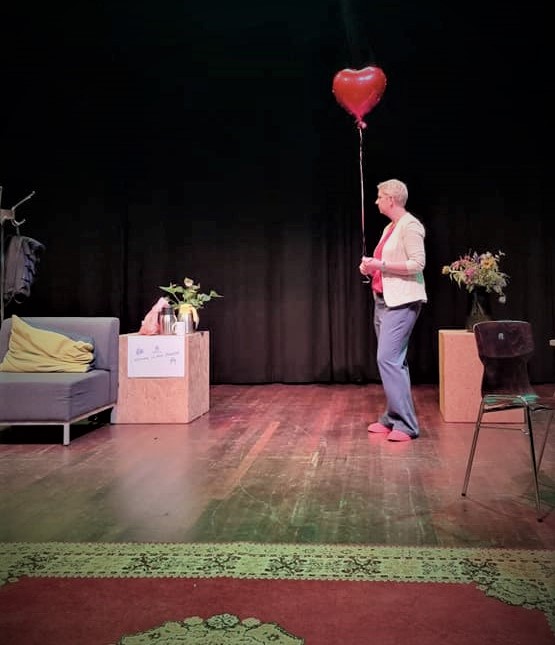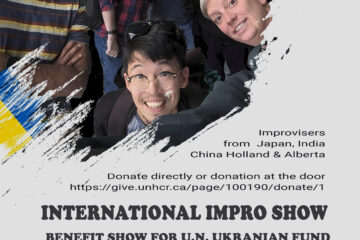THOUGHTS, IDEAS, QUESTIONS, PROCESS, LESSONS,
Student Post
Follow The Body – A series of exercises
Cindy Pittens – Week 6
The body knows – A series of physical contact improvisation exercises developed by Shawn Kinley.
Exercise: Follow the body
Shawn asked us this week to write down an exercise.
This one will stick with me. I want to practise this exercise another 1000 times. This is why. Let’s begin with the series of exercises and how it works.
Follow the body
We often use our brains to understand what the next step in the story is. But our body, most of the time is ahead of this. It’s very useful to learn to listen to the signals.
This is a series of exercises that are designed to slow your mind down, to teach you to focus on your body (and most importantly to find real contact with another person). To use this awareness of the body, to connect with the other player and find a common pace and understanding of what your body is telling you.
There is a buildup in these exercises that brings players from a playful in a more and more mindful state. You also build up trust and intimacy in the group.
In all exercises you can choose to use music that has a minful/chill sound. Preferably, no lyrics.
1st Get you off balance
Pair up and stand face to face.
Try to bring the other person out of balance. Push or pull (without grabbing) the shoulders, hips or legs. When the other person has to take a step – reset yourselves and try again.
Debrief could be about:
– What happens to you when you “win / lose”?
– What moments are the ones that help you?
– Do you have a tactic?
2nd New partners
Change partners a couple of times.
Debrief in between the new pairs, could be about?
– Are you aware of the differences between the players?
– How do you adapt to these changes?
– Did you find different tactics?
In improvisation scenes, you are always with a different scene partner. You have to be aware of the (body)language and signals of this person and be willing to adapt to this scene partner.
3rd Catch (save)
Now add the next part: Play as you did before with one exception. As soon as your partner is about to lose balance, (because of your pushing/pulling), catch them and bring them back into balance.
Debrief could be:
This is all about being 100% present and aware of where the other player is. Not get lost in celebrating your winning, but stay connected and do what’s needed to keep your scene partner present and still take care of them.
4th Touch back of the hands (STICKY HANDS – Shawn Kinley)
New exercise in pairs, face to face.
Hold your hands up, with the back of the hands towards the other player. Gently let the back of the hands touch the other player’s back of the hands. Try to create no resistance. Just touch.
Your goal is to touch the head/shoulder of the other player.
When you feel movement, you follow the movement. When you feel resistance, try to give in to it. Don’t fight for a direction. Use the momentum of the movement to find a way to the head/shoulders.
Debrief could be:
– What did you experience?
– Were you aware of any resistance?
– There can be a tendency to want to control. How did that go for you?
– Did you get stuck sometimes? Were you only moving your hands, or did you use the whole body to let the movement happen?
Vary with:
A. Change partners a couple of times.
B. Get people into trios as well and see what happens.
C. How much you support competition. Depending on the goal of this exercise, you can put more playfulness in competition. But if you put more attention on trying to create no resistance, people get more mindful.
5th Hand Improvisation
Sit in pairs, face to face. If possible on the ground or on chairs. And, if comfortable with it, with your eyes closed.
Same exercise with the back of the hands against each other.
But: now take out the competition element.
The goal is shifted to the awareness of micro movements and to ‘follow the follower’.
As you sit, with the back of your hands touched, DO NOT INITIATE MOVEMENT.
You only RESPOND, when you feel the other person’s hand is moving. You go along with this movement. Don’t give any resistance. Move, when moved. And so be always following.
Debrief could be:
– What did you experience?
Change pairs a couple of times
Debrief could be:
– What differences did you notice?
– How did you respond to those differences?
– Do you have a tendency? Move fast/slow or are your hands close to you or to the other?
6th Back to back
Sit with your backs against each other and as the former exercise, follow the micro movements.
Debrief could be:
– What did you notice?
– Are you focussed on your own experience? Does this distract you from staying connected to the other person?
7th Scenework
Let’s take this experience into scenes.
We have an impactful ‘goodbye-scene’.
Someone leaving for a long time, which has a big emotional impact on the characters
For instance:
– At the airport, the mother and child
– two best friends, end of high school
– at work, two colleagues.
Script
We create a short script, by playing it once neutral.
A scene where we have a short goodbye and then when both are stepping away, we get back to each other for a moment for that last goodbye. A hug or a handshake happens, or some touch of the body that helps us follow the body. We know that there is a reason to leave, there even might be a plane leaving or a taxi waiting. But we follow the bodies in the micromovements of goodbye.
This could end up in a minutes-long goodbye.
Debrief could be:
– Did you fully commit to the body-tempo and signals?
– Were there moments where the brain took over?
– What did the brain tell you?
Maybe this comes up:
This is more important: the story/audience/fear of the other person’s thoughts in this intimate situation?
– What has the audience experienced? What moments were engaging or when did you lose interest?
Personal take aways
I think for me this is a great exercise. I had a couple of super insightful takeaways.
– When I play, especially competitive games, I tend to lose the awareness of taking care of others. I want to win. But it’s not about winning. It’s about finding the state of awareness and presence together. Sometimes you help the other to stay awake and put them in balance a bit. Sometimes you help them get back in balance again.
– When I dive into my own body and emotional experience, I tend to lose connection with the other. I so much enjoy my rich inner world, which is so nice for me, that I forget to be aware of the other person and their micro movements.
– On the other hand, when my brain is interfering, because of fear of failure, perfectionism, or wanting to use the right technique or tell the ‘right’ story, I lose connection with my own body and lose the awareness of its important part in exactly knowing what to do.
Thanks for reading.
If you want to read more about my trip and insights?
Follow www.facebook.com/cpimp




0 Comments